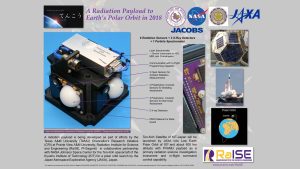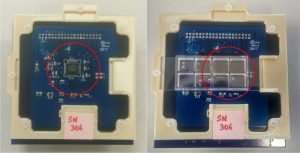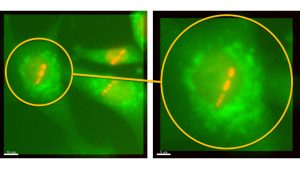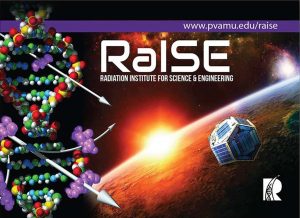Texas A&M University (TAMU) Chancellor Research Initiative (CRI) expands innovative space radiation detectors
Radiation Institute for Science Engineering (RaISE) at Prairie View A&M University developed and launched two first-of-its-kind space radiation measurement payloads.
Recently, we designed and developed two innovative space radiation payloads with lowest mass (< 1 kg) volume (< 1 U), lowest power requirements (~ 1 W), highest resolution for radiation particle measurements (with about 5 micron per pixel resolution of complementary metal oxide semiconductor (CMOS) sensors), with a unique data transmission from deep space via radio frequency waves (directly from the spacecraft). We built both of our space payloads at the NASA Johnson Space Centre in the US.

Our first payload – radiation Particle Pixel Detector (PPD) was launched into deep space onboard the Shinnen-2 spacecraft of KIT-Japan that was spun off along with the Hyabusa-2 (asteroid exploration mission) of JAXA – Japan in 2014. Our second payload – Solar and Heliospheric Assessment of Radiation Particles (SHARP) Charged Particle Detector (CPD) was launched into polar orbit onboard the Ten-Koh spacecraft of KIT-Japan in 2018 by the H2 rocket of JAXA – Japan. Both payloads successfully collected and transmitted data through the onboard spacecraft’s own radio frequency communication portals. Our first payload received the highest recognition and honours from the Japanese Science and Engineering Society in 2016 for successfully collecting radiation data and transmitting from deep space onboard the Shinen-2 spacecraft near Venus’ orbit.
PPD: First ever deep-space radiation measurements via radio waves
The first ever CMOS-based radiation particle detector launched to deep space has been successful and proved to be promising for several other advancements, with the following five unique features:
- PPD payload the Shinen2 spacecraft, has been in an elliptical orbit around the Sun (migrating between Venus and Mars orbits crossing the Earth’s orbit), was launched on 3 December, 2014, as part of the Hayabusa2 (an asteroid exploration mission for a second sample return objective).
- Shinen2 spacecraft, designed and built by the Kyushu Institute of Technology (KIT-Japan), is a hexagonal shaped, 15-kg, 47 x 49 x 49-cm structure built with lightweight and durable Carbon Fiber Reinforced Polymer (CFRP) with dual batteries charged by solar panels on each side of the structure and redundant UHF transmission at 437 MHz.
- Shinen2 proved its success by transmitting data from the Moon orbit and beyond. Shinen2’s only payload is a radiation detector designed and built by Prairie View A&M University (PVAMU) in collaboration with NASA Johnson Space Centre (NASA-JSC), the University of Texas (UT-Austin), and the University of Nevada, Las Vegas (UNLV).
- The radiation particle pixel detector (PPD), a 10 x 10 x 10-cm cube structure was designed and developed as: (i) low weight (~ 800 gr), (ii) low power (~ 1 W), (iii) high reliability over few years (~ 5+ years), (iv) high tolerance in deep-space harsh radiation environment for a broad range of temperatures (-50°C to +50°C), and (v) with a unique capability to provide data downlink over a low bit rate communication transmission to Earth (few kilobytes) from deep-space.
- Our payload, PPD, uses two CMOS sensors and custom designed radiation-hardened field-programmable gate array (FPGA) to sustain the deep-space radiation environment with capability to estimate energy and particle flux – typically, 85% of protons and 14% of the alphas of the Galactic Cosmic Ray (GCR) composition in deep space that varies as a function of the solar cycle.
SHARP-CPD: First ever x-ray measurements with CMOS sensors
The first of its kind, SHARP-CPD payload that was built and launched as part of the Ten-Koh Spacecraft of Kyushu Institute of Technology, KIT-Japan, for Earth’s Polar Orbit on October 29, 2018 by JAXA, Japan and has been in Earth’s Polar Orbit at 93 degrees at an altitude of ~ 600 km.

This unique payload is comprised of six Radiation Sensors, two X-Ray Detectors, and one Particle Spectrometer. This groundbreaking combination of sensors can be best categorised into seven salient features:
- The Liulin particle spectrometer, custom developed by the Bulgarian Academy of Sciences (BAS), was designed to collect radiation measurements in conjunction with PVAMU’s six other Radiation Sensors for an even more dimensional comparison.
- One set of two radiation sensors are covered with polyethylene spheres that will be collecting data on radiation shielding effectiveness over time. `
- Another set of two sensors are covered with polystyrene for assessing dose measurement over an extended time period.
- There are two open sensors to gather ambient radiation measurements.
- The SHARP-CPD payload’s pioneering design also features a set of two sensors integrated with scintillating material for detecting X-rays in the polar orbit.
- The entire frame structure is built with 3-D printed PEKK material for low-static electrical interference that allows for the best possible data collection to date.
- Finally, this payload boasts in-flight command control capability, allowing access to manage data collection protocols of all sensors independently.
For live tracking and ten-day future predictions of Ten-Koh Spacecraft from your location, CLICK HERE.
More on Shinnen-2 and Ten-Kho from RaISE-USA.
More on Shinnen-2 and Ten-Kho from KIT-Japan.
Principal partners:
• Professor Saganti (USA) – Principal Scientist
• Professor Holland (USA) – Principal Engineer
• Professor Cucinotta (USA) – Principal Modelling
• Professor Okuyama (Japan) – Principal Architect
• Professor Dachev (Bulgaria) – Principal Measurements
Radiation Track Structure Detector (TSD): For the finest micro dosimetry and the highest resolution of the real-time imaging
• CMOS sensor dimensions: 0.644 cm (H) x 0.461 cm (V)
• Total active pixels: 3664 (H) x 2748 (V) = 10,068,672
• Each pixel size: 1.67 µm x 1.67 µm
• Entire unit: 10 cm x 10 cm x 2 cm (Sensor Board +
Control Board) on a 3D printed holder
Recently, we developed a CMOS (complementary metal oxide) based space radiation Track Structure Detector (TSD) system for capturing and analysing heavy ion tracks at cellular dimensions with a 1.67 microns per pixel resolution and more than 10 M pixels on a ~ 1 cm² sensor.



To characterise the heavy ion particle track structure at micron level, we collected data with several heavy ions of varying energies including carbon ions at NASA Space Radiation Laboratory (NSRL) of the Brookhaven National Laboratory (BNL) – USA, and with carbon ions at the at the Heavy Ion Medical Accelerator in Chiba (HIMAC) facility – Japan. Due to recent widespread interest in particle therapy for various treatment applications, we calibrated our track structure detector for several ions, including helium, carbon, oxygen, and iron ions (55 MeV through 300 MeV) at NSRL and HIMAC. All our experiments with detector systems are augmented with biological samples making use of a custom-built chamber slide adopter designed to reside atop of the sensor unit for correlating spatial distribution of the track structure and trajectory impact at cell dimensions.
Our data of particle track images at micron resolution with our custom-developed CMOS sensor units are very promising for interpreting the track length and spatial distribution of radiation at cell dimensions. Also, our data is promising for studying fragments along the particle trajectory. Results of carbon ion tracks and cell impacts will be presented along with other heavy ion track structure observations. These TSDs will be improved for 3D data at cellular dimensions in the near future and can be custom-developed for various medical applications for real-time assessment of various ground-based radiation treatment options, as well as human space exploration operations, as needed.
Research support:
USA – Seth Saganti, Sonia Kolluri, Mahmudur Rahman, Ramesh Dwivedi, Brain Cudnik, Gary Erickson, Richard Hagan, Xiaodong Hu, Jordan Rhone, Andrew Beitman, Kareena Menezes, Megumi Hada, Huichen Wang.
Japan – Isai Fajardo, Jesus Gonzalez-Llorente, Rafael Rodríguez.
Bulgaria – Plamen Dimitrova, Borislav Tomova, Yuri Matviichuka.
Germany – Shannon Adler contributed and compiled this publication.

Please note, this article will also appear in our Space Special Focus publication.



